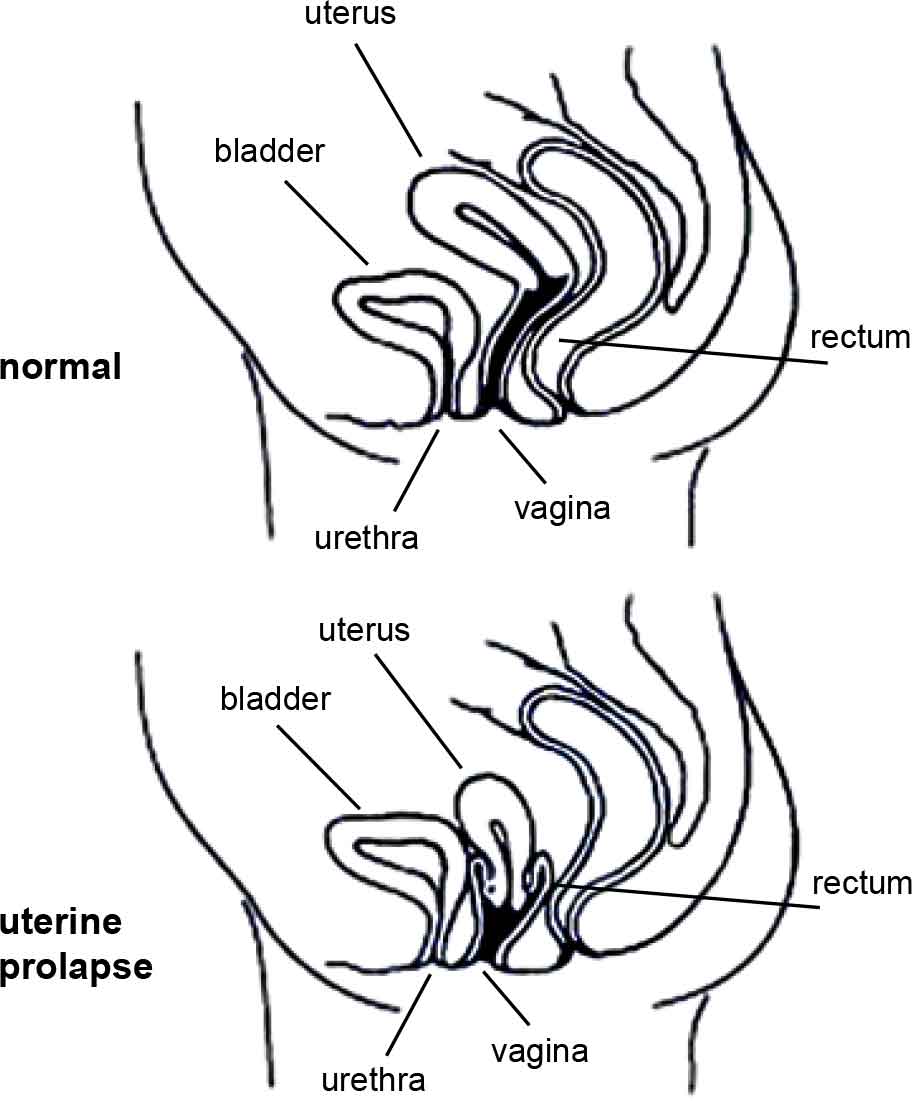<
What is a vaginal (or pelvic organ) prolapse?Your pelvic organs include your bladder, uterus (womb) and rectum (back passage). These organs are held in place by tissues called “fascia” and “ligaments”. These tissues help to join your pelvic organs to the bony side walls of the pelvis and hold them inside your pelvis. Your pelvic floor muscles also hold up your pelvic organs from below. If the fascia and ligaments are torn or stretched for any reason, and if your pelvic floor muscles are weak, then your pelvic organs (your bladder, uterus, or rectum) might not be held in their right place and they may bulge down into the vagina (birth canal). | 甚麼是陰道(或骨盆器官)下垂?骨盆器官包括膀胱,子宮及直腸(肛門)。這些器官由被稱為“筋膜”及“韌帶”的組織固定位置。這些組織幫助將骨盆器官連接到骨盆壁上,從而將它們保持在盆骨內。骨盆底肌肉亦將骨盆器官托起。如果筋膜及韌帶因某種原因被撕裂或拉傷,而且如果骨盆底肌肉無力,骨盆器官(膀胱,子宮,或直腸)或不能保持在適當位置而墜入陰道(產道)內。 |
What are the signs of prolapse?There are a few signs that you may have a prolapse. These signs depend on the type of prolapse and how much pelvic organ support has been lost. Early on, you may not know you have a prolapse, but your doctor or nurse might be able to see your prolapse when you have your routine Pap test. When a prolapse is further down, you may notice things such as:
These signs can be worse at the end of the day and may feel better after lying down. If the prolapse bulges right outside your body, you may feel sore and bleed as the prolapse rubs on your underwear.
| 骨盆器官下垂有哪些徵兆?有一些徵兆顯示你可能有骨盆器官下垂。這些徵兆取決於下垂的類型以及骨盆器官失去支撐的程度。最初你可能不知道自己有骨盆器官下垂,但醫生或護士替你做例行子宮頸抹片檢查時可能會看見下垂的器官。 當下垂進一步往下時,你可能會留意到下列徵兆:
這些徵兆晚上可能會更嚴重,而躺下之後會感覺好一點。如果下垂物突出體外,在它摩擦內褲時你會感到疼痛並會出血。
|
What causes prolapse?The pelvic organs are held inside the pelvis by strong healthy fascia. They are held up from below by pelvic floor muscles that work like a firm muscle sling. If the support tissues (fascia and ligaments) that keep the bladder, uterus and bowel in place inside the pelvis are weak or damaged, or if the pelvic floor muscles are weak and saggy, then prolapse can happen. Childbirth is the main cause of prolapse. On the way down the vagina, the baby can stretch and tear the support tissues and the pelvic floor muscles. The more vaginal births you have, the more likely you are to have a prolapse. | 骨盆器官下垂的成因?骨盆器官由結實健康的筋膜保持在盆骨內,並由像牢固的肌肉吊索一樣的骨盆底肌肉將其托起。如果在盆骨內固定膀胱,子宮及直腸的支撐組織(筋膜及韌帶)變弱或受損,或者如果骨盆底肌肉衰弱及鬆弛,就會出現下垂。 分娩是骨盆器官下垂的主要原因。胎兒沿著陰道往下時,會拉扯及撕裂支撐組織及骨盆底肌肉。你經歷的陰道產次數越多,出現骨盆器官下垂的可能性就越高。 |
 |  |
Other things that press down on the pelvic organs and the pelvic floor muscles that can lead to prolapse, are:
| 其他壓迫骨盆器官及骨盆底肌肉並會引起下垂的因素包括:
|
Types of prolapsePelvic organs may bulge through the front wall of the vagina (called a cystocele [sist-o-seal]), through the back vaginal wall (called a rectocele [rec-to-seal] or an enterocele (enter-o-seal]) or the uterus may drop down into your vagina (uterine prolapse). More than one organ may bulge into the vagina. | 骨盆器官下垂的類型骨盆器官會向陰道前壁突出(稱為膀胱突出症),向陰道後壁突出(稱為直腸突出或陰道後疝),或子宮落入陰道內(子宮脫垂)。可能會有不止一個器官下垂入陰道內。 |
Who is likely to have a prolapse?Prolapse tends to run in families. It is more likely after menopause or if you are overweight. But it can happen in young women right after having a baby.
| 哪些人有可能出現骨盆器官下垂?骨盆器官下垂趨向於家族遺傳。絕經之後或超重時更有可能出現,但也可能出現在剛剛生完孩子的年輕女性身上。
|
What can be done to help prevent prolapse?It is much better to prevent prolapse than try to fix it! If any women in your close family have had a prolapse, you are more at risk and you need to try very hard to follow the advice given here. As prolapse is due to weak pelvic tissues and pelvic floor muscles, you need to keep your pelvic floor muscles strong no matter what your age. Pelvic floor muscles can be made stronger with proper training (See the brochure “Pelvic Floor Muscle Training for Women”). It is important to have your pelvic floor muscle training checked by an expert such as a pelvic floor physiotherapist or a continence nurse advisor. If you have been told you have a prolapse, these experts are the best people to help plan a pelvic floor muscle training program to suit your needs. | 可以做些甚麼來預防骨盆器官下垂?預防骨盆器官下垂比盡力治療好得多!如果你的近親家庭中有任何女性曾經患骨盆器官下垂,你的風險就更高,需要想方設法地按照這裡提出的建議去做。 由於骨盆器官下垂的起因是骨盆組織及骨盆底肌肉乏力,無論你是甚麼年齡,都需要保持骨盆底肌肉結實。 骨盆底肌肉可以透過適當的鍛練而結實 (請參閱小冊子“女性骨盆底肌肉鍛練”)。重要的是,要請骨盆底理療師或排便科護士等專家檢查你的骨盆底肌肉鍛練方法。如果你已得知自己有骨盆器官下垂,這些專家是幫你制訂一個適合你所需的骨盆底肌肉鍛練計劃的最佳人選。 |
What can be done to treat prolapse once it has happened?Prolapse can be dealt with simply or with surgery—it depends on the level of prolapse. The simple approach Prolapse can often be treated without surgery, chiefly in the early stages, and when the prolapse is mild. The simple approach can mean:
The surgery approach Surgery can be done to repair the torn or stretched fascia and ligaments. Surgery can be done through the vagina or the tummy. Sometimes special mesh is placed into the front or the back vaginal wall to strengthen it where it is weak or torn. As the body heals, the mesh helps form stronger tissues to give more support where it is needed. After surgery To prevent the prolapse coming back again, you should make sure you:
The diagrams have been reprinted with kind permission from Women’s Health Queensland Wide’s Genital Prolapse factsheet. | 一旦出現骨盆器官下垂,可以做些甚麼治療?骨盆器官下垂可以透過簡單方法或手術進行處理—取決於下垂的程度。 簡單方法 對骨盆器官下垂的治療通常無需手術,主要是在早期以及下垂輕微時進行。簡單方法是指:
手術方法 可以通過陰道或腹部手術修復被撕裂或拉傷的筋膜及韌帶。有時會將特製的粗網放入陰道前壁或後壁來增強薄弱或被撕裂的地方。隨著身體康復,粗網能幫助形成更結實的組織,在所需地方提供更強的支撐。 手術之後 為了預防骨盆器官下垂復發,你要確保:
圖表獲授權取自昆士蘭州婦女健康服務(Women’s Health Queensland Wide)的生殖器脫垂說明。 |
Seek helpQualified nurses are available if you call the National Continence Helpline on 1800 33 00 66* (Monday to Friday, between 8.00am to 8.00pm Australian Eastern Standard Time) for free:
If you have difficulty speaking or understanding English you can access the Helpline through the free Telephone Interpreter Service on 13 14 50. The phone will be answered in English, so please name the language you speak and wait on the phone. You will be connected to an interpreter who speaks your language. Tell the interpreter you wish to call the National Continence Helpline on 1800 33 00 66. Wait on the phone to be connected and the interpreter will assist you to speak with a continence nurse advisor. All calls are confidential. * Calls from mobile telephones are charged at applicable rates. | 尋求幫助如果你致電國家排便節制熱線,有資質的護士會接聽你的電話1800 33 00 66* (週一至週五,澳大利亞東部標準時間8:00am—8:00pm)。
如果你在講英語或者理解上有困難,你可以透過撥打13 14 50獲取免費電話傳譯服務以接通國家排便節制熱線。電話會用英語接通,因此請說明你要講的語言並且不要掛機。你會被連接到一個講你母語的傳譯員。告知傳譯員你想要致電國家排便節制熱線,電話是1800 33 00 66。待電話接通後傳譯員會幫助你與排便節制護理顧問對話,所有的來電均保密。 * 用手機打出會收取相應費用。 |

